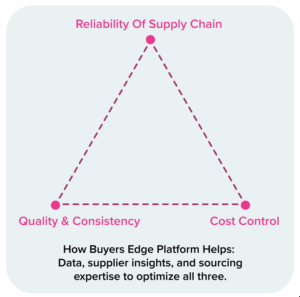A robust procurement sourcing process is more than just a back-office function; it’s your competitive advantage as foodservice costs rise and supply chains change. For restaurant groups, hotels, senior living facilities, and retail foodservice operators, procurement directly impacts profitability, quality, and guest experience.
Procurement, however, can be complicated. It is easier to understand and optimize when it is divided into the ten essential sourcing stages. Let’s go over each step and how Buyers Edge Platform helps operators make the process more efficient.
What is Procurement in Foodservice?
The process of finding, acquiring, and buying everything you need to operate your business, from equipment and linens to fresh ingredients and cleaning supplies, is known as procurement in the foodservice industry. When procurement is done correctly, it guarantees:
- Availability of products
- Reasonably priced and trustworthy
- On-time delivery that keeps your kitchens functional
- Long-term, solid supplier relationships
An effective procurement sourcing process gives operators insight into expenditures, reduces waste, and frees up time to concentrate on the visitor experience.
Why the Procurement Sourcing Process is Important

Finding the best deal isn’t the only goal of procurement. Reliability of the supply chain, quality, and cost control must all be balanced. For instance:
- In order to maintain low food costs, a chain of restaurants may need to standardize ingredients across all of its locations.
- Strict quality and nutritional requirements for residents must be met by a senior living operator while keeping costs under control.
- It is possible for a hotel to need high-end linens and facilities without raising operating expenses.
The procurement sourcing procedure lays the groundwork for effectiveness and profitability in each area of an operation.
10 Steps in the Procurement Sourcing Process

1) Figure Out What You Need
Make sure you know exactly what you need before anyone talks about price. This is where you put the specs, pack sizes, expected volume, delivery windows, and quality standards. Tight inputs lead to tight results.
- Real-world example: A casual dining group decided to start selling a blackened chicken sandwich. Culinary finalizes the spec (4 oz breast, IQF, no antibiotics ever), purchasing models weekly case volume by location, and ops sets delivery windows around prep schedules.
- How Buyers Edge Platform helps: We pull past purchasing and menu data to size demand, recommend PAR levels, and flag spec nuances like catch weight vs. fixed weight that affect true landed cost.
2) Look at Possible Vendors
Not every vendor that says “yes” is a good fit. Check for food safety certifications, fill rate history, lead times, regional coverage, and the ability to grow with you. The total value is more than the sticker price.
- Real-world example: A small boutique hotel looks at three different linen suppliers. One is the least expensive, another has better OTIF performance, and the third lasts longer, which means you won’t have to buy replacements as often.
- How Buyers Edge Platform helps: Buyers Edge Platform helps operators make better, more informed decisions by making it easier to compare suppliers based on price, quality, and service.
3) Create the RFP and Send It Out
Good RFPs take the guesswork out of things. Include the final specifications, the number of deliveries per DC or location, the frequency of deliveries, the compliance requirements, and how proposals will be judged. Serious bidders are drawn to clear inputs.
- Real-world example: A multi-unit concept seeks a beverage program refresh. The RFP details fountain vs. bottled mix, national and regional needs, equipment support, and marketing funds.
- How Buyers Edge Platform helps: We standardize templates, inject market benchmarks, and distribute to vetted suppliers to increase competitive, compliant bids.
4) Compare Proposals and Pick the Suppliers
This is where math meets judgment. Don’t just look at the unit price; also look at the shipping costs, fuel surcharges, minimum order quantities, shrinkage, substitution policies, and implementation timeline.
- Real-world example: A senior living operator looks at two bids for poultry in the real world. The lower price means longer lead times and higher minimums, which can cause inventory to rise. The slightly higer price includes local stock, a longer shelf life, and fewer shorts.
- How Buyers Edge Platform helps: Buyers Edge Platform gives operators tools to review bids side by side so decisions are based on real value, not just price.
5) Negotiate the Contract
Lock in the rules of the road. Set SLAs, fill rate goals, OTIF limits, price-hold periods, index-based changes, credit timelines on shorts, and early-pay discounts.
- Real-world example: A fast-casual brand negotiates produce with quarterly price caps tied to commodity indices, plus credits issued within 10 days for variances outside tolerance.
- How Buyers Edge Platform helps: Buyers Edge Platform supports operators with insights and expertise that strengthen supplier partnerships and help secure fair, competitive terms.
6) Send Out The Purchase Order
A purchase order is the single source of truth. Being accurate here will save you a lot of trouble later. Check the item numbers, packing, price, shipping address, and requested arrival dates.
- Real-world example: A chain of convenience stores sets up standing POs for sauces that can be kept on the shelf and seasonal bump orders for football weekends.
- How Buyers Edge Platform helps: Buyers Edge Platform makes the purchase order process easier, cutting down on errors and simplifying it for operators to manage orders with confidence.
7) Manage Fulfillment
Great suppliers communicate. Operators track ASNs, watch for subs, and adjust labor and prep when trucks move. Real-time visibility keeps 86s off the board.
- Real-world example: A concept using pre-cut veg gets a weather delay alert. Prep swaps to a backup salad build and avoids overtime while the delivery slides 24 hours.
- How Buyers Edge Platform helps: Buyers Edge Platform provides visibility that helps operators track deliveries and keep supply moving smoothly from vendor to kitchen.
8) Receive and Verify Goods
Receiving includes checking the quality of what you received. Checking the temperature, counting and verifying specs, and checking the shelf life all help keep guests and profits safe. Make sure to document everything.
- Real-world example: A K-12 team rejects a portion of a chicken shipment due to temp and logs it for credit.
- How Buyers Edge Platform helps: Buyers Edge Platform simplifies the receiving process by helping operators confirm orders against expectations and reduce mistakes.
9) Approve the Invoice and Pay
Check the PO, receipt, and invoice against each other. Find price differences, fix misbilled prices, and make sure shorts and subs are in balance.
- Real-world example: A multi-unit brand finds a $0.14 difference on a high-velocity SKU in the real world. The correction saves thousands of dollars every quarter.
- How Buyers Edge Platform helps: Buyers Edge Platform makes it easier to validate invoices and process payments quickly, helping operators avoid discrepancies and save time.
10) Evaluate Performance
The procurement sourcing process ends with learning. Quarterly business reviews and supplier scorecards drive continuous improvement.
- Real-world example: A hotel group reviews OTIF, case-fill, quality holds, and corrective actions with a linen partner before renewal.
- How Buyers Edge Platform helps: Buyers Edge Platform gives operators tools to evaluate supplier performance so they can strengthen relationships and improve results over time.
Buyers Edge Platform Makes the Procurement Sourcing Process Easier

Buyers Edge Platform is more than just a platform; it’s a partner in every step of the procurement sourcing process. We help operators by combining technology, data, and strategic supply chain knowledge to do the following:
- Cut costs without giving up quality
- Strengthen relationships with suppliers
- Automate manual tasks
- Get a full picture of your spending and buying
The procurement sourcing process doesn’t have to be difficult for foodservice operators. Buyers Edge Platform solutions are strategic and designed to increase profitability.

